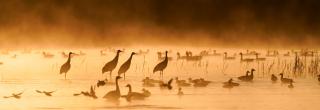
Wetlands
Description and Key Features
A wetland is an area that is inundated or saturated by surface or groundwater long enough to support vegetation typically adapted for life in saturated soil.
Wetlands are classified depending on how long water and vegetation are present.
These range from temporary wetlands that typically hold water for only a few weeks, to permanent wetlands that hold water yearround.
North Dakota has about 2.4 million acres of wetlands remaining from an estimated 5 million acres that once existed (Figure 21).
The highest wetland densities are in the Missouri Coteau and Drift Prairie, collectively known as the Prairie Potholes region.
Some areas contain more than 150 wetlands per square mile.
However, the destruction and alteration of wetlands, particularly shallow temporary basins, is widespread due to draining, filling, burning, farming, and other practices.
From 1997 to 2009, over 50,000 basins were lost, representing a 3.3% overall decrease.
Wetlands within cropland may lack emergent vegetation, while those in pasture or rangeland often suffer from overuse and degradation due to cattle.
Wetlands are highly dynamic, influenced by weather cycles, and may experience periods of drought or flooding.
Conservation efforts for many SGCNs and other wetland-associated wildlife depend on maintaining a mosaic of wetlands and grasslands.
While no specific focus areas for conservation have been identified, nearly all wetlands are crucial for water filtration, surface water storage, and providing essential wildlife habitat.
Wetlands Classification Relationships
- The Midwest Landscape Initiative developed Voluntary Lexicon and Best Practice Recommendations for Midwest State Wildlife Action Plans (May 2024). In line with recommendation 2.1, the following Macrogroup and Group classifications from the United States National Vegetation Classification System (USNVC) pertain to wetland habitat in North Dakota.
- Macrogroup: M069 Eastern North American Marsh, Wet Meadow & Shrubland https://www1.usgs.gov/csas/nvcs/unitDetails/860627
- Group: G125 Eastern North American Freshwater Marsh https://www1.usgs.gov/csas/nvcs/unitDetails/837180
- Group: G770 Midwest Wet Prairie, Wet Meadow & Shrub Swamp https://www1.usgs.gov/csas/nvcs/unitDetails/894450
- Macrogroup: M071 Great Plains Marsh, Wet Meadow, Shrubland & Playa https://www1.usgs.gov/csas/nvcs/unitDetails/860542
- Group: G35 Great Plains Freshwater Marsh https://www1.usgs.gov/csas/nvcs/unitDetails/857034
- Group: G336 Great Plains Wet Prairie, Wet Meadow & Seepage Fen https://www1.usgs.gov/csas/nvcs/unitDetails/857050
- Group: G337 Great Plains Riparian Wet Meadow & Shrubland https://www1.usgs.gov/csas/nvcs/unitDetails/857066
- Macrogroup: M077 Great Plains Saline Wet Meadow & Marsh https://www1.usgs.gov/csas/nvcs/unitDetails/860569
- Group: G324 Great Plains Saline Wet Meadow & Marsh https://www1.usgs.gov/csas/nvcs/unitDetails/848823
- Group: G534 Western Great Plains Saline Wet Meadow https://www1.usgs.gov/csas/nvcs/unitDetails/860851
- Macrogroup: M877 North American Boreal & Subboreal Alkaline Fen https://www1.usgs.gov/csas/nvcs/unitDetails/907538
- Group: G183 Midwest Prairie Alkaline Fen https://www1.usgs.gov/csas/nvcs/unitDetails/835830
- Wetland Types
- Permanent - surface water is present throughout the year in all years.
- Permanent Wood-bordered - deep surface water is present year-round, and the wetland periphery is predominantly woodland.
- Semipermanent - surface water is present year-round in most years. During dry years, however, water may disappear as early as midsummer.
- Seasonal - surface water is present for extended periods in spring and early summer but usually disappears during late summer and fall.
- Temporary - surface water present for a brief period during early spring following snowmelt and occasionally for several days following heavy rainstorms during the late spring, summer, and fall.
- Alkali - highly saline shallow water and alkali salt flats.
- Working Wetlands (cropped wetlands) - occur in basins with soils that are frequently cultivated.
- Fens - surface water is sometimes lacking but bottom soils saturated by alkaline ground-water seepage.
- Slope Wetlands - occur primarily in southwest North Dakota.
- Macrogroup: M069 Eastern North American Marsh, Wet Meadow & Shrubland https://www1.usgs.gov/csas/nvcs/unitDetails/860627
Wetlands Map

Figure 21. Estimated current extent of emergent wetlands (blue), forested wetlands (dark green), and working or cropped wetlands (tan).
Wetlands Images

Emergent Wetland

Emergent Wetland

Working or Cropped Wetland
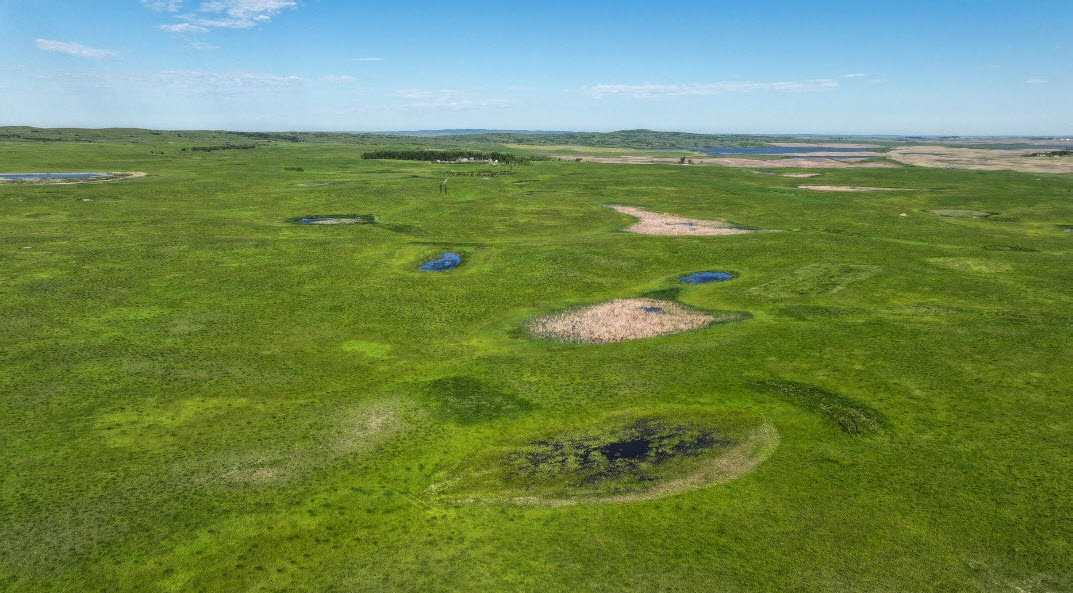
Restored Wetland
Associated Species
Note: Species listed here include SWAP SGCN and game species.
| Species Image | Species | Taxon | Subtaxon or Group |
|---|---|---|---|
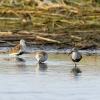
|
Dunlin | Birds | Shorebird |
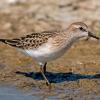
|
Semipalmated Sandpiper | Birds | Shorebird |

|
Short-billed Dowitcher | Birds | Shorebird |

|
Hudsonian Godwit | Birds | Shorebird |
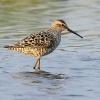
|
Stilt Sandpiper | Birds | Shorebird |
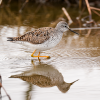
|
Lesser Yellowlegs | Birds | Shorebird |

|
Willet | Birds | Shorebird |

|
Long-billed Curlew | Birds | Shorebird |
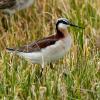
|
Wilson’s Phalarope | Birds | Shorebird |
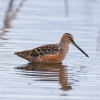
|
Long-billed Dowitcher | Birds | Shorebird |

|
Marbled Godwit | Birds | Shorebird |
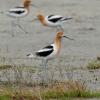
|
American Avocet | Birds | Shorebird |
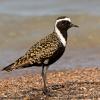
|
American Golden-Plover | Birds | Shorebird |
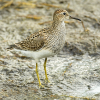
|
Pectoral Sandpiper | Birds | Shorebird |

|
Buff-breasted Sandpiper | Birds | Shorebird |

|
Ruddy Turnstone | Birds | Shorebird |

|
Short-eared Owl | Birds | Landbird |
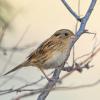
|
LeConte’s Sparrow | Birds | Landbird |

|
Nelson’s Sparrow | Birds | Landbird |
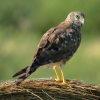
|
Northern Harrier | Birds | Landbird |
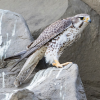
|
Prairie Falcon | Birds | Landbird |
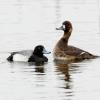
|
Lesser Scaup | Birds | Waterfowl |

|
Northern Pintail | Birds | Waterfowl |

|
Canvasback | Birds | Waterfowl |

|
Franklin’s Gull | Birds | Waterbird |
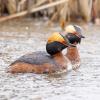
|
Horned Grebe | Birds | Waterbird |
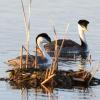
|
Western Grebe | Birds | Waterbird |
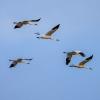
|
Whooping Crane | Birds | Waterbird |

|
Yellow Rail | Birds | Waterbird |
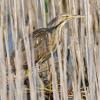
|
American Bittern | Birds | Waterbird |
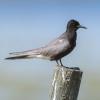
|
Black Tern | Birds | Waterbird |

|
American Toad | Amphibians | Toad |

|
Plains Hog-nosed Snake | Reptiles | Snake |
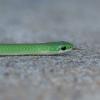
|
Smooth Green Snake | Reptiles | Snake |

|
Snapping Turtle | Reptiles | Turtle |

|
Broad-Winged Skipper | Terrestrial Invertebrates | Skipper |

|
Dion Skipper | Terrestrial Invertebrates | Skipper |

|
Yellow-banded Bumble Bee | Terrestrial Invertebrates | Bumble Bee |

|
Mulberry Wing | Terrestrial Invertebrates | Butterfly |

|
Monarch Butterfly | Terrestrial Invertebrates | Butterfly |

|
Subarctic Darner | Aquatic Invertebrates | Dragonfly |
